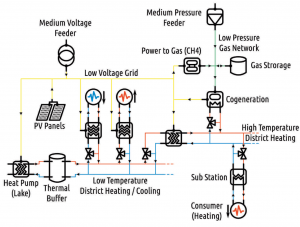Source: ERA-NET Smart Cities and Communities (ENSCC)
Partner: KTH, Romande Energie SA, City of Vevey, CREM, HES-SO Valais-Wallis, AIT, AEE INTEC, Hoval AT, CT GE, SIG, EPS, Veolia Sverige AB, Holdigaz SA, Riksbyggen, ElectriCITY, City of Stockholm
Duration: 2016 – 2019 (36 months)
External website: https://jpi-urbaneurope.eu/project/interg-city/
Abstract:
Nowadays, energy supply networks in cities – natural gas, electricity and heating/cooling – are almost always planned and operated separately from each other. This “silo-like” approach prevents energy utilities and city planners from:
- Identifying synergies opportunities among the networks, as to increase reliability and robustness of energy supply;
- Optimally planning heavy infrastructure investments, thus taking into account future energy demand evolutions while avoiding oversizing.
This Era-NET Smart Cities project therefore aims at maximizing the use of renewable energy through the integration of advanced energy conversion technologies and the interconnection of urban energy networks transporting natural gas, electricity or water for heating/cooling. Synergies between networks are identified as well as the evolution of the energy demand, including electric mobility. An integrated IT decision-support tool will be developed and tested in three Swiss and Swedish cities.
As of today, no known IT tools allows applying the integrated perspective to multi-energy networks and this constitutes the main objective of IntegrCiTy project. The latter aims at developing an integrated decision-support environment for city planners and energy service providers, in order to improve efficiency and resilience of urban infrastructures for energy supply, focusing on the de-ployment, extension and retrofitting of energy networks, as well as on interaction between multi-energy networks.
The IntegrCiTy approach and tools will enable :
- the understanding of each network mechanism to anticipate the impact of a new energy system upon the spreading of already existing network and the implementation of a new one.
- the potential complementarities between multiple energy infrastructures. This requires simulating the effect of new configurations on existing networks to determine which prospective model is the most efficient, meets future demand, best takes advantage of resources, is cost-effective and promotes inter-operability of ex-isting and new infrastructure
The overall goal of the tool is to provide the decision-making process with adequate support as to improve network profitability in this context, while guaranteeing a more sustainable, reliable and strong energy supply system.
The proposed decision-support environment will be based on the co-simulation principle. . Co-simulation consists in modelling different sub-systems (networks and technologies) separately from the whole (territorial energy systems). This will allow approaching territorial energy systems as a whole under an integrated perspective.


Energy technologies integrated in the multi-energy platform including electric grid, gas network and district heating lines.
Contact persons: Luc Girardin (luc.girardin@epfl.ch)
Project-related publications
Please note that the publication lists from Infoscience integrated into the EPFL website, lab or people pages are frozen following the launch of the new version of platform. The owners of these pages are invited to recreate their publication list from Infoscience. For any assistance, please consult the Infoscience help or contact support.